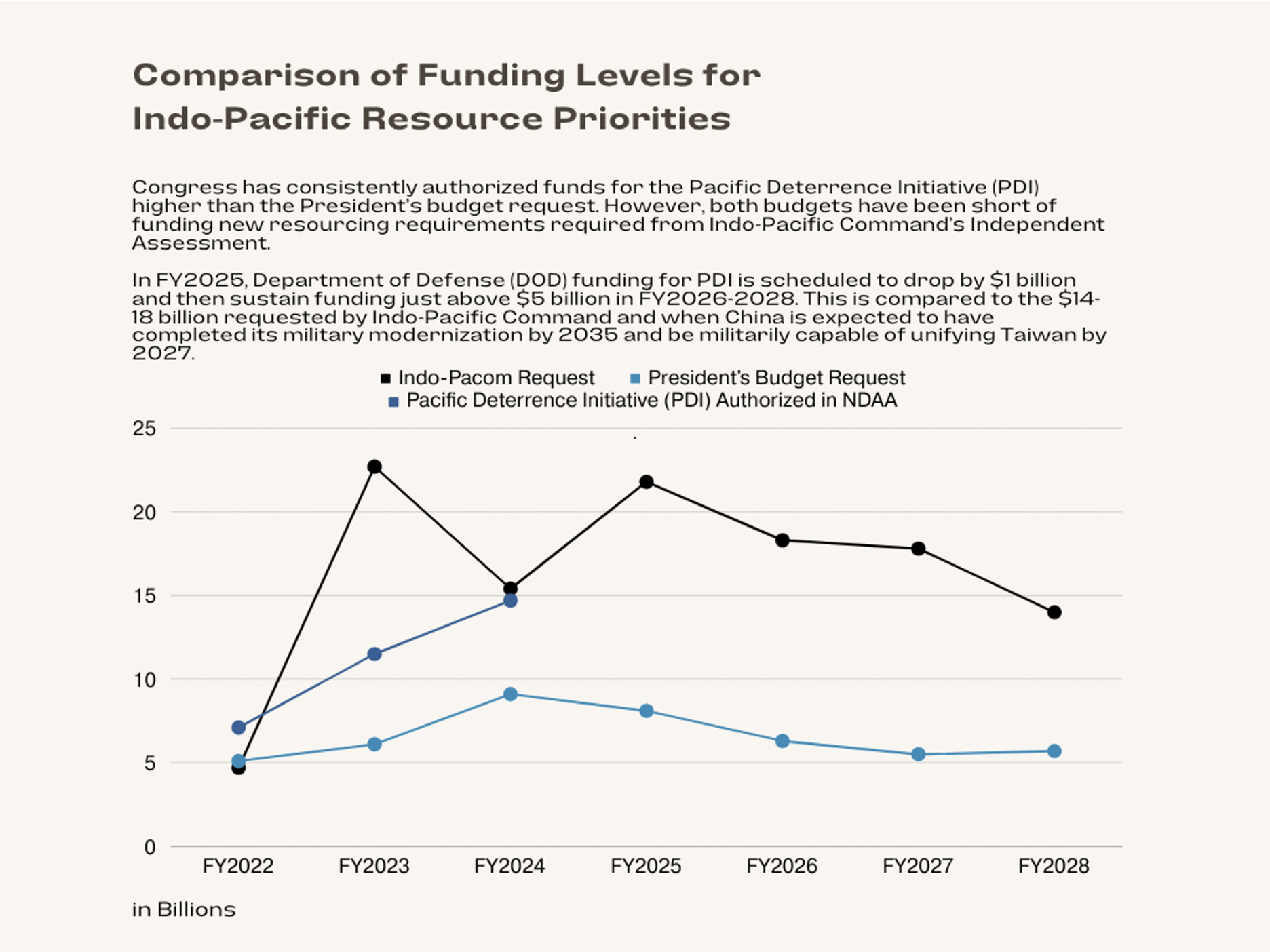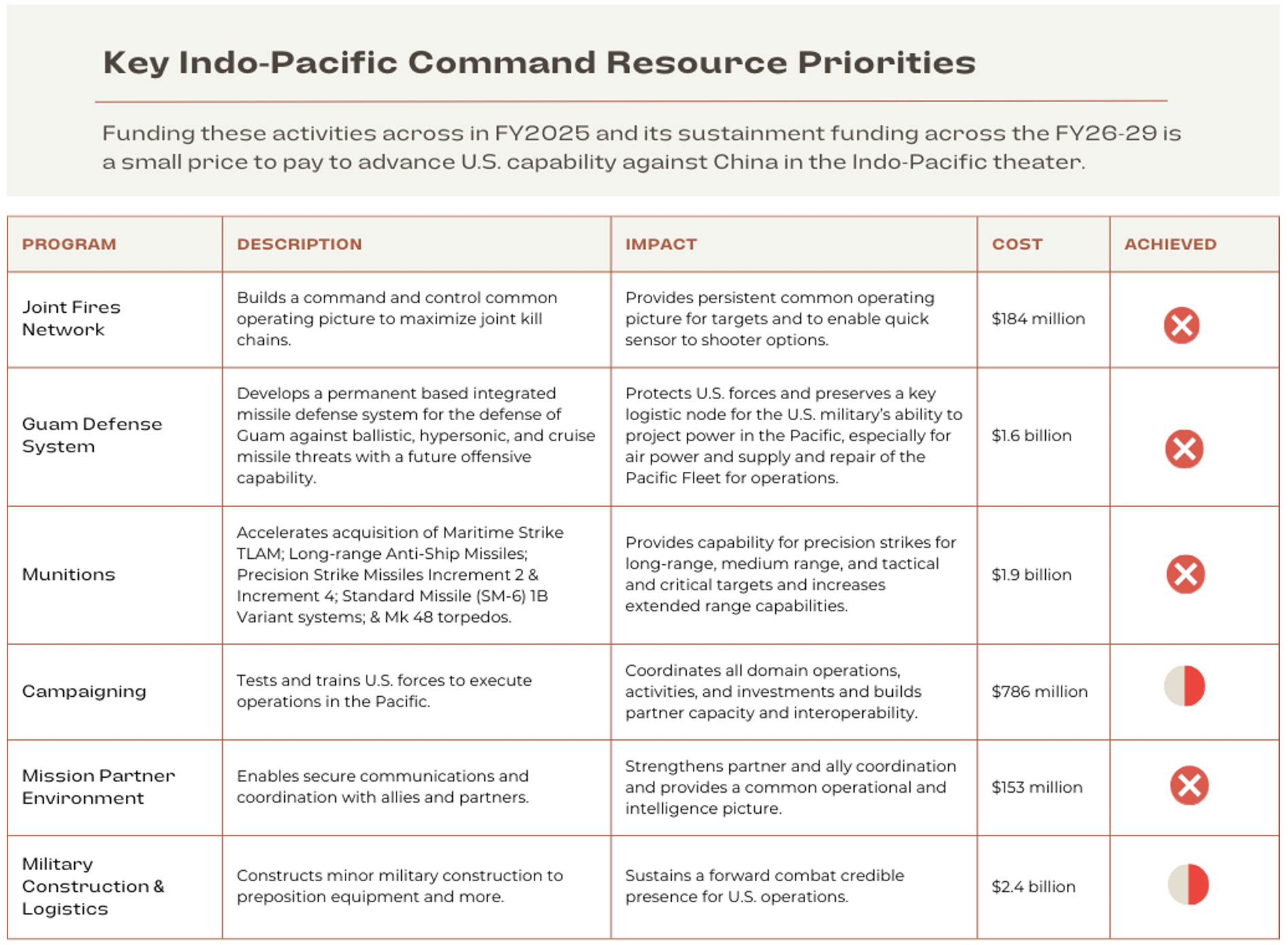
The USNS Yukon and the USS Ronald Reagan transit the South China Sea on Oct. 27, 2023. U.S. Navy / Petty Officer 3rd Class Jordan Brown
To deter China, transform the Pacific Deterrence Initiative
Three things are required to enable the PDI to meet its vital objectives.
While the Pentagon waits for Congress to pass a budget for the fiscal year that’s one-third over, the world moves on. A new year brings a new federal budget cycle, despite the delays in getting last year’s spending enacted. Unfortunately, world events and America’s security needs do not wait for our legislative process to catch up. One national security priority with widespread bipartisan support is deterring both conflict and Chinese aggression in the Indo-Pacific. Despite our political agreement, however, achieving that goal seems to be growing more elusive than ever.
In 2023 alone, China conducted unsafe and dangerous maneuvers against U.S. military aircraft, rammed Philippine vessels in the South China Sea, and sent fighter jets and warships into the Taiwan Strait on almost a daily basis, often crossing the median line that has served as an unofficial barrier between the two sides. In fact, the risk of escalation and conflict by Beijing is higher now than it has been for years.
Concerned about trends in the Pacific, we proposed the Pacific Deterrence Initiative (PDI) in April 2020. The idea had roots in the European Deterrence Initiative (EDI), in conversations with key allies at the Shangri-La Dialogue, and in congressional frustrations with the Pentagon.
EDI was established in 2014, just after Russia’s invasion of Crimea. It became a key source of funding to improve U.S. European Command’s (EUCOM) posture after Russia’s blatant aggression. It required EUCOM commander and the Office of the Defense Secretary to look strategically at how the region should be postured, what forces should be rotated through the area, and what other training, exercises, and key capabilities were necessary to conduct operations. Importantly, EDI was fully funded in the first few years of its existence, putting additional funds toward specific projects rather than just slapping a new label on plans already underway. Each year, EUCOM and the Office of the Secretary review the program to take a comprehensive, strategic look at what was needed to improve U.S. posture and capability further, reporting to Congress on their findings. Many of those investments have been particularly welcomed and needed after Russia’s 2022 invasion of Ukraine.
The leading defense conference in Asia is the Shangri-La Dialogue, hosted by the International Institute for Strategic Studies (IISS) in Singapore each year. Top DOD officials attend, as well as many national security-minded members of Congress. Meetings there between U.S. lawmakers and delegates from other nations center around steps the U.S. and partners could take to discourage Chinese aggression.
Like its European predecessor, PDI was born out of frustrations with slow, half-measures emanating from the Pentagon. For two years in a row, the National Defense Authorization Act required the Pentagon to report to Congress specifically on what additional resources were needed to deter China. The Pentagon failed to do so. One was reminded of former Defense Secretary Robert Gates, who quipped in a different context that the troops may be at war, but the Pentagon was not.
The example of the EDI, conversation with allies and partners, a sense of urgency in the Pacific region, and frustrations with the Pentagon led Congress to create the PDI under the 2021 NDAA. Congress authorized PDI to provide new funding for a variety of purposes, including an integrated air and missile defense system on Guam, more funding for rotational forces, prepositioned munitions, and logistics as well as funding for military construction, programs to enhance ally and partner capacity, and joint training and exercises. The law also mandated that the commander of INDOPACOM report annually to Congress on the resource requirements for PDI.
Falling short
As we approach the fourth year of its creation, PDI has fallen short of expectations. There have been improvements in some areas, but DOD has primarily used PDI as a budget display for programs related to the theater rather than as a strategic plan to fund and increase military capability and capacity. It has also failed to fulfill the needs identified by INDOPACOM’s Independent Assessments, which have been “specifically designed to persuade potential adversaries that any preemptive military action will be too costly and likely to fail by projecting credible, combat power at the time of crisis” and to provide “several flexible deterrent options including full OPLAN execution if deterrence should fail.”
In its 2024 budget proposal, the Administration requested $8.1 billion for PDI, far less than INDOPACOM’s assessment that $15.4 billion would be needed. Congress bumped that up by $5 billion—a 47 percent increase—in the 2024 NDAA signed into law by President Biden last month. Lawmakers specifically added money for several items on INDOPACOM’s unfunded-priority list, including campaigning, munitions, and investments for an initial prototype providing a distributed, resilient Joint Fires Network for command and control. It is a start, but it also shows the large gap between what Congress and INDOPACOM think is needed and what the Office of Secretary of Defense and the OMB have designated.

Year after year, the shortfalls between the needs and the funding to meet those needs continue to accumulate, and it is becoming increasingly difficult to catch up within any timeline that matters. As an example, it will take years to complete needed military construction projects needed for storage and pre-positioning of equipment and munitions and to improve military and defense infrastructure, basing, logistics, and assured access takes years to complete—years we may not have.
PDI needs more
As China increases its assertive behavior and Chinese leader Xi Jinping repeats his aggressive statements about absorbing Taiwan the window is quickly closing for the U.S. to provide credible deterrence that can make a difference. INDOPACOM has listed several key priorities (see figure below), which include defending critical U.S. military sites, including Guam, positioning critical munitions and equipment forward, training U.S. forces with enabling capabilities that increase the lethality of the Joint Force while strengthening our coordination with allies. But much of what it says is necessary has not been achieved or funded.

To help PDI meet its vital objectives, we believe that three things are required.
First, PDI should provide additional funding for various items to improve our posture and capabilities west of the international dateline and thus deterrence: ("Additional” here means more than has been planned, not just more than we have spent in the past.)
Guam Defense System. Build a permanent integrated air missile defense system to protect Guam from ballistic, hypersonic, and cruise missiles while also providing the foundation for a future offensive capability. The island is a crucial base for operations and logistics, and key to winning any extended fight in the region.
Munitions: Build, buy, and send to the Pacific a package of precision strike standoff weapons for attacking long-range, medium-range, and tactical targets. These weapons include Maritime Strike Tomahawk (MST); Precision Strike Missiles—Increment 2 (PRSM); the Standard Missile 6 (SM6-1B variant); Long Range Anti-Ship Missiles (LRASMs) and Joint Strike Missiles, and Joint Air-to-Surface Standoff Missile Maritime missiles as well as Mk 48 Advanced Capability Torpedoes are critical for the protection of forward-deployed forces against enemy countermeasures designed to push the United States out of the region.
Fuel storage and prepositioned equipment. Position fuel, military equipment, and munitions that would be needed for operations and resupply if fixed U.S. military installations in the region are no longer available. The time to ship these materials across the Pacific would be too long in a time of conflict.
Campaigning. Provide the capacity to quickly mass forces multiple times a year as part of a persistent, synchronized set of operations, activities, and investments in the western Pacific and Indian Oceans to familiarize and train forces with the challenges associated with the operating environment and what to expect if satellites, communications, and air defenses are down.
Indo-Pacific Mission Network (also known as Mission Partner Environment). Provide the ability to securely communicate and collaborate with multiple allies and partners and modernizes the command, control, communication, and computer and information technology infrastructure to assure command and control in a contested environment.
Military construction and design. Fund minor military construction to enable INDOPACOM to use current authorities to develop and deliver footprint requirements promptly. This infrastructure would stock equipment, preposition kits, and other build other small facilities that would provide a more dispersed footprint.
Joint experimentation, innovation, and training. Fund theater-wide exercises to inform and strengthen the ability of joint and combined forces to execute all-domain operations in contested environments.
Security cooperation. Fund Title 10 USC Section 333, Train and Equip; USC Section 332, Institutional Capacity Building; and Maritime Security Initiatives (MSI) authorities to develop critical capabilities of allies and partners in theater to improve integrated deterrence.
Second, Congress should ensure that PDI has its own appropriations account or total obligation authority rather than a subset of the broader DOD budget for the region. PDI is meant to supplement other activities, not be a new label attached to a catalogue of activities and programs already planned. Having PDI as part of a bigger account masks the real resources required to fund INDOPACOM’s needs. A dedicated and sustained appropriations or TOA to enhance posture and capabilities west of the international dateline must include both near-term and long-term investments that execute the capabilities that the combatant commander needs. And recent events have reminded us that we should not just increase funding in the Pacific by taking away funding from Europe and the Middle East. More is required.
Third, PDI funding must be sustained and build off of the progress that the Department has made over the last few years with force posture access agreements throughout the region, including the announcement of four Enhanced Defense Cooperation Agreement sites in the Philippines, moves made with Australia and Japan, including supporting Japan’s decision to acquire new capabilities to strengthen regional deterrence, provisions to Taiwan with self-defense capabilities, better cooperation within the Quad partnership of India, Australia, Japan, and the United States, and the deepening trilateral relationship with South Korea and Japan. This progress strengthens our alliances and coordination of key partners and builds their defense resiliency, adding to our deterrence posture in the region against threats from adversaries. We should use PDI to make U.S. and allied posture more credible and more resilient.
Why this matters
Simply, time is running out. The pace of China’s aggressive actions in the region and military modernization buildup is accelerating at a rapid pace. In his annual new year speech to the nation, Xi said “reunification” of Taiwan and China was a “historical inevitability,” a line he similarly repeated in his December address marking the 130th anniversary of the People’s Republic of China founder Mao Zedong’s birth, when he said that the “reunification” of Taiwan with China is “inevitable.” We should take these words seriously as they demonstrate Xi’s growing impatience of the current status quo.
Our military must have the credible strength to project power in the Indo-Pacific, protect our forces, and meet our treaty obligations. With that strength and with close coordination with our allies and partners, our actions must be designed to dissuade Xi from waking up one day and deciding to test U.S. resolve.
The next budget cycle and the follow-on years are critically important to truly demonstrate that the resource requirements that the Commander said he needs are met. Our politics agree. We need to act to fully fund the Pacific Deterrence Initiative and the Commander’s resource requirements. The time to do that is now.
Mac Thornberry is a former Texas congressman who served as chairman of the House Armed Services Committee.
Kimberly Lehn is a senior associate (non-resident) at the Center for Strategic and International Studies, a senior fellow (non-resident) at the Center for Strategic and Budgetary Assessments and was a professional staff member on the House Armed Services Committee.



